The days I spent in Campitello di Fassa had been sublime, allowing me to acclimate to the higher elevations. It served as a good prelude to my return to Cortina d’Ampezzo, where the main event awaited—trekking from mountain hut to mountain hut and climbing Via Ferrata routes along the way. I was eager to rendezvous with the SCMA gang; our collective anticipation for this six-day expedition self-evident. We had waited for eight long months—and now it was showtime.
⥪⥪⥪⥪⥪⥪⧫⥬⥬⥬⥬⥬⥬
Cortina d'Ampezzo
Nestled in the picturesque Ampezzo Valley, Cortina is an upscale resort town renowned for its alpine scenery; a haven for both winter skiing and summer outdoor activities. With a population of around 6,000 (8 times larger than Campitello), Cortina can swell to 40,000 during peak ski season. It hosted the 1956 Winter Olympics and is set to host the Games again in 2026.
I arrived back in Cortina on a sunny Thursday afternoon. After returning the rental car, I checked into the Hotel Panda, a restful haven that would be our home base when not in the backcountry. Half of the SCMA (Southern California Mountaineers Association) gang was already there, buzzing with excitement; the other half would arrive Friday afternoon via the Cortina Express from Venice Airport. Our trip was set to begin Saturday morning, with twelve of us in total—most of whom I've known for over twenty years. Wonderful cohorts, all.
LeRoy, SCMA member extraordinaire, had organized the trip through his friend Jörg, a seasoned German-Canadian alpine guide who owns OnTop Mountaineering. Jörg’s expertise was invaluable for arranging all the hut lodging, trekking itinerary, and a sundry of details that would assure the trip ran smoothly. Accompanying him was Paul, his Canadian associate and fellow guide. These additions increased our party to fourteen.
By Friday night, we were all together at last, keen for what lay ahead. We celebrated in town over a scrumptious dinner on an outdoor patio shaded by big trees. All for one and one for all. Tomorrow would mark the beginning of a new adventure.
 |
| Entrance to an Olympic village. |
My room at Hotel Panda.
 |
| Downtown Cortina d'Ampezzo |
 |
Hiking with good friends, Ben & Pam, on the day before trip started.
|
 |
| Pam and Lorrie on a trail above Cortina. |
 |
| Cortina d'Ampezzo |
 |
The SCMA "Dirty Dozen". Starting at lower left and going clockwise: LeRoy, Margo, Lorrie,
Rob, Gio, Ben, Pam, yours truly, Yvonne, Mihaela, Mary Jo, and Gary. (photo by Jörg) |
 |
Alpine guides, Jörg (standing at right) and his associate,
Paul, going over details the night before we depart. |
Rifugios & Hüttes
The Dolomites boast a network of around 1,000 mountain huts, ranging from expansive chalets to small rustic cabins. About 600 of these are owned or maintained by the Italian Alpine Club, while others are managed by various organizations or private enterprises. They are built to endure harsh winters and provide shelter and accommodations for those venturing into the alpine backcountry on foot (or skis). Some have hot showers. Some are off the grid. And many are without road access.
Interestingly, many Dolomite huts have two names: one in Italian, and another in German. The Italian "rifugio" is often paired with the German "hütte" (example: Rifugio Pian di Cengia–Büllelejoch Hütte). Two names, one hut. This symmetry reflects the region's cultural tapestry, especially in South Tyrol—the Italian province that borders Austria—where over half the population considers German their native language.
Via Ferratas
A Via Ferrata is a unique climbing route in mountains that uses steel cables, rungs, and ladders permanently attached to the rock (via ferrata is Italian for “the iron way”). This innovative approach allows climbers to secure themselves to metal fixtures, significantly enhancing safety while navigating otherwise dangerous vertical terrain.
The origins of Via Ferrata trace back to the 19th century in the Alps, where they were initially developed for practical purposes. During World War I, they gained further significance by aiding troop movements along the Alpine Front in the Dolomites. Today, there are close to a thousand Via Ferrata routes that are maintained on a regular basis. These routes are rated by difficulty grades, from "A" (easy) to "E" (extremely difficult), allowing climbers to better choose a path that suits their abilities.
Day 1: Ferratas Ra Gusela & Mt. Averau
In the morning, we learned that one in our crew, Gio, was out. He had spent the night heaving in the bathroom, leaving us concerned about what might be affecting him. After a quick test, we were relieved to hear he tested negative for COVID, but that only deepened our uncertainty. Was it the flu? Food poisoning? We didn’t know. He had no choice but to stay behind at Hotel Panda to rest and recover. It was a stark reminder of how quickly things can change.
Passenger vans shuttled us up to Giau Pass (7,300 ft.), where a scenic 90-minute hike ascended around to the precipitous east face of Mt. Ra Gusela. Despite the early hour, the sun was already beating down, prompting many of us to strip down to shorts and t-shirts. We reached the start of Ferrata Ra Gusela (A-rating) soon after, where the going was easy, but much steeper. A mix of cable-protected climbing sections, rough trail, and boulder-hopping led us up a rocky spine ridge to Rifugio Nuvolau for lunch—and after gaining 1,200 feet in elevation, we were famished! The view from our lunch spot at Nuvolau was incredible—a panoramic feast for the eyes that made every ounce of effort worthwhile.
After lunch, we hiked further down the ridge to Rifugio Averau, which would be our lodging for the night, and where our afternoon objective loomed straight above: Mt. Averau. It was a daunting 800-foot climb with a ferrata section (B-rating). Seven in our party were game to tackle it. I, however, found myself dehydrated and humbled after the morning’s exertion and chose to sit this one out. All I craved was rest and water.
 |
| Starting off from Giau Pass. The giant tower is Ra Gusela. |
 |
| Ferrata Ra Gusela. |
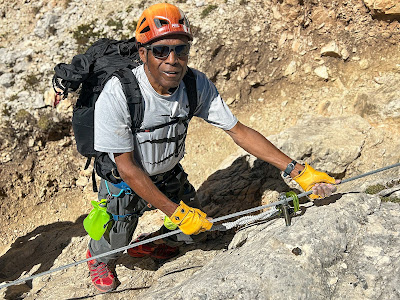 |
| LeRoy is a founding member of the SCMA. Our Obi-Wan Kenobi. |
 |
Margo is also a founding member of the club.
(photo by Jörg) |
 |
Gary, trying not to smile.
(photo by Jörg) |
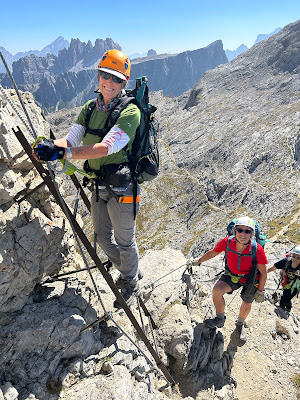 |
Mary Jo, always smiling. That's Lorrie below her.
(photo by Jörg) |
 |
Yvonne has the best luck—won most of the
rope raffles at club meetings back in the day.
(photo by Jörg) |
 |
Rob - current club prez.
(photo by Jörg) |
 |
| Mr. Ron (photo by Jörg) |
Rifugio Nuvolau
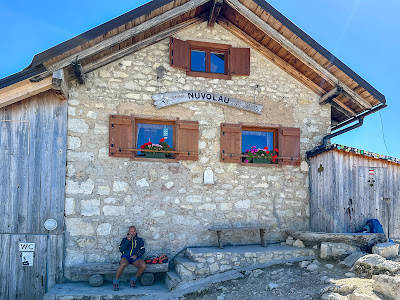 |
| In 1883, the Baron of Dresden funded the construction of the original mountain hut (the region was part of Austrian Empire until 1918). The shelter later played a role during World War I as an Italian observation post on the Alpine Front. Its strategic location led to frequent shelling, causing extensive damage. In 1930, the Italian Alpine Club rebuilt the hut and named it Rifugio Nuvolau. There is no road access; supplies are delivered by cable lift. Today, the rifugio can accommodate up to 20 guests. |
The outdoor grill at Rifugio Nuvolau.
 |
Lunch on Rifugio Nuvolau terrace.
|
 |
Rifugio Averau, where we spent the first night. The original hut was constructed in
1903 by an Austrian family. During World War I, the Italian Army used it as a field
headquarters crucial to military operations on the Alpine Front. After the war, the
structure fell into disrepair. The original owners attempted to renovate in the 1970s,
but their efforts were unsuccessful, leaving the hut neglected until another family
purchased it in 1980 and completed the renovation. It operated as such for nearly
three decades, but recognizing the need for modern amenities, a brand new rifugio
was built on the site in 2010. This larger, more contemporary facility features hot
showers and can accommodate up to 40 guests. |
 |
| The view from our Averau bunk room. |
 |
The summit of Mt. Averau (8,690 ft.)
(photo by Rob)
|
 |
Our cozy bunk room.
(photo by Rob)
|
 |
| Dinner at the rifugio. |
Day 2: Ferrata Fusetti
After a hearty breakfast, we ambled down to Rifugio Scoiattoli, enjoying the stunning views along the way. The crisp mountain air was invigorating, and the anticipation of what lay ahead added a spring to our step. Once we arrived at the rifugio, we took the cable car down to the highway, where taxis waited to shuttle us to Falzarego Pass. There were two ferrata options for the day—Col dei Bos or Fusetti. Jörg would lead five of us, including myself, up Fusetti, while his associate, Paul, would lead the other six in our party up Col dei Bos. At the end of the day, the two groups would rendezvous at Rifugio Lagazoui, where we were spending the night.
The Fusetti party, which consisted of Jörg, LeRoy, Margo, Pam, Michaela, and me, was dropped off at the north end of Mt. Sas de Stria. We picked up the trail leading around to the southwest face of the butte, where we encountered 500 vertical feet of slabs, roofs, and corners rising into the sky. This was it: we clipped into the cable and started climbing. It didn’t take long for me to realize this was much more strenuous than yesterday’s Ferrata Ra Gusela.
We topped out on the shoulder of Mt. Sas de Stria, where we paused for lunch and soaked up the incredible view. Afterwards, we explored the old WWI tunnels and fortifications that honeycombed the mountain, remnants from another time. This was part of the Front Line, where the Italian Army and their Austrian adversary had fought it out over a century ago. It would’ve been nice to linger longer, but it was getting late. Jörg led the scramble down to the highway, and then we hiked a mile down the road to the Lagazoui Aerial Tram at Falzarego Pass. Needless to say, the ride up to the mountain station—over 2,000 vertical feet—felt like icing on the cake to an adventurous day.
Rifugio Lagazoui sits next to the mountain station of the aerial tram, perched at the edge of a sheer drop-off and boasts, without question, one of the best views in the Dolomites. The Col dei Bos party arrived about an hour after us. We checked into the rifugio, where I shared a room with Gary and Mary Jo—another room with a stellar view. But the best news of the day was being reunited with Gio! He was feeling much better and had taken the tram up to join us. His droll wit had truly been missed by all, and we celebrated his return at dinner with a toast—the "Dirty Dozen" was back together again!
 |
| Sunrise view from Rifugio Averau. |
 |
| The morning hike down. Five Towers in the background. |
 |
Beware of hitchhikers. Getting a ride up to
Falzarego Pass with Mihaela and LeRoy.
|
 |
The approach to Ferrata Fusetti.
|
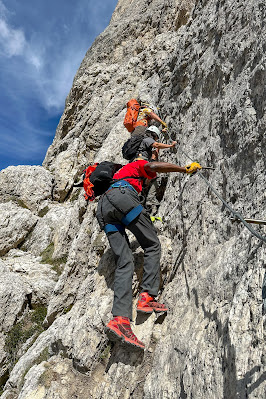 |
Scaling up Ferrata Fusetti. The route was named after
Lieutenant Mario Fusetti, an Italian Army officer who was
killed in action in 1915 near the summit of Sas de Stria.
The via ferrata was originally put up to rescue Fusetti and
his men, who were pinned down by Austrian forces.
|
 |
Mihaela goes after it.
|
 |
The steepest section of the headwall.
|
 |
| The view from the top of Ferrata Fusetti. |
 |
| Remnants of fortifications near summit of Sas de Stria. |
 |
| Exploring... |
 |
| Machine gun position. |
 |
| Lagazoui Aerial Tram. |
 |
Rifugio Lagazuoi is near the summit of Mt. Lagazuoi (9,300 ft.), a mountain
that is a veritable rock fortress, riddled with tunnels and fortifications
from WWI. The aerial tram was built in 1964 and the rifugio opened the
following year. It is privately owned and accommodates up to 50 guests
in private rooms, with hot showers and a sauna.
|
 |
Sauna with a view.
|
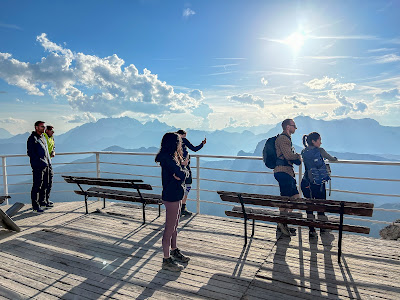 |
| The rifugio terrace. |
Supplies are ferried up to the rifugio by chopper from Falzarego Pass .
(video by Jörg)
 |
"We're the Fukawee."
Ben and Rob scout their way to Rifugio Lagazoui after climbing Ferrata Col dei Bos.
(photo by ? ) |
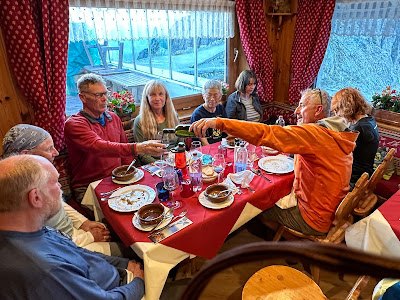 |
Jörg keeps the wine flowing at dinner.
|
 |
Gio is back!
(photo by Rob)
|
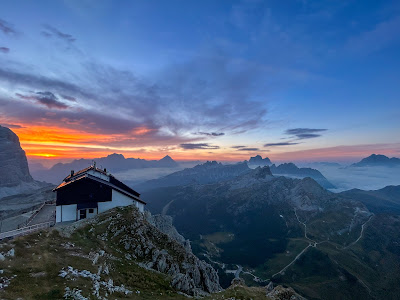 |
| Nightfall, Day 2. |
⥪⥪⥪⥪⥪⥪⧫⥬⥬⥬⥬⥬⥬
At the end of Day 2, I found myself reflecting, graced by a spectacular sunset. It was good to have Gio back in the fold, his laughter and energy adding zest to our little tribe. Jörg shared his thoughts about a possible change in the weather—clouds were brewing, hinting at what might come. Maybe so. But tonight, there was undeniable magic in the air that made all worries fade away. Everyone turned in early and slept soundly. Tomorrow was another day.


















































Fabulous post Ron!! The pics, video, and narrative really bring the Dolomites & your crew to life. I've had the good fortune to visit this area once and would love to go again. Molte grazie!!
ReplyDelete